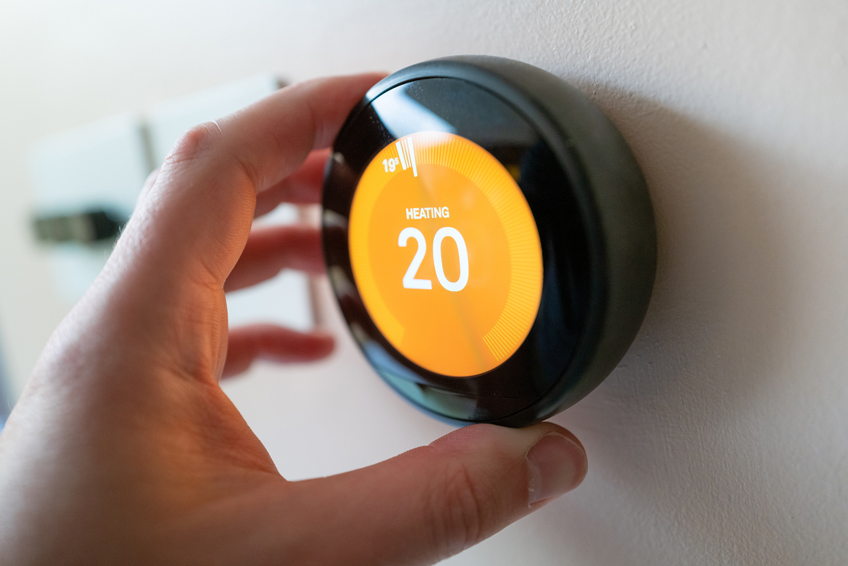It’s so simple that it’s often overlooked but your thermostat can be costing you more than you realize.
If your home is more than a few years old, chances are good that you have an older thermostat on you heating and air conditioning (HVAC) systems. The oldest ones have manual dials or sliders to control the room temperature. You move the indicator to the temperature you want and a coiled bimetallic switch expands or contracts causing the switch to open or close based on the air temperature around it. It may control your heating system, air conditioning, or both, depending on the type of system you have.
These simple, inexpensive thermostats work well enough but they depend on you to tell them what to do and when to do it. Today’s thermostats take over most of that work, making it more likely that you’ll use your HVAC system more efficiently.
Automated Temperature Control
Programmable thermostats have saved countless BTUs and kilowatts since their introduction over thirty years ago. They let you set your system to heat or cool to different temperatures based on when you need it. You can set them to your home, work, and sleep cycles to keep energy use on a schedule, saving gas and electricity costs.
Switching to a programmable thermostat is a great way to cut down on energy use—as long as you program it properly. If that’s not your cup of tea, Wi-Fi technology offers even more convenience.
Smart Thermostats Keep You Connected
We live in a connected world and it’s making life easier, safer, and more efficient in a lot of ways. So-called smart thermostats use Wi-Fi and cellular technologies to take energy-saving and comfort to a new level.
We’re already in a fourth generation and there’s more to come. Nearly all major manufacturers like Honeywell, GE, and Emerson have smart thermostats along with tech companies like Google, Nest, and Amazon. With some smart thermostats, you don’t even have to program them. Just adjust the temperature to a comfortable level on the digital thermostat; it remembers the setting and when you set it. After a few days, it learns your heating and cooling patterns and takes it from there.
They Know When You Come and Go
Some smart thermostats go even further, using a smart phone app with GPS to know when you’re home or away and adjust temperatures accordingly. Coming home early on a cold winter night? Systems that use a GPS technique called geofencing adjust the thermostat so you won’t come home to a frigid (or sweltering) house. They will also alert you on your smart phone if your home gets too hot or cold, a nice feature to have if you’re away for extended periods—even out of the country.
They Play Well with Others—Even Strangers
Most smart thermostats will integrate with other smart systems like security and lighting for complete home automation. And if you use voice controls like Amazon Alexa or Google Home, many will operate over your Wi-Fi network or via Bluetooth. Some systems even track your energy usage and offer suggestions for increased efficiency.
But like any internet-connected devices, smart thermostats can be vulnerable to hackers. Be sure that any connected devices—from routers to baby monitors—are made by trusted companies and have strong password protection. Also be aware of the company’s data collection policies and opt out of any you’re not comfortable with.
Security issues have arisen with many so-called smart devices, so be careful with what you put on your home network and always keep your home WiFi, browser, and antivirus software up to date.
For more in-depth information, read How Hackers Strike Your Home on the Allstar Electrical website.
Is Your Thermostat Wired for High Tech?
Most thermostats run on a 24-volt low-voltage circuit, but not all do, especially in older homes. Even if you have the right voltage, you may not have enough wires to connect to a smart thermostat properly.
Unlike standard (and some programmable) thermostats, smart thermostats require constant power to stay connected to your home network. This is usually via the “C” wire, and it’s not present in some installations. The installation guide for your new thermostat should tell you what’s needed, or you can look it up on the internet before purchasing.
DIY or Don’t?
If you have the right wiring, in the right place, and you’re reasonably handy, you can probably change thermostats yourself. But if you need additional wiring or to move the thermostat’s location, you should call a licensed electrician. They will know how to do the job safely, up to code, and with the minimal amount of disruption.
Confused? Give Allstar a Call
Whether it’s home automation, adding extra power, or electrical repairs, the pros at Allstar Electrical Services have been serving homeowners and businesses along Colorado’s Front Range for over 20 years. We’re top-rated by the Better Business Bureau and are proud to be listed as a preferred contractor by Angi’s Home Advisor.
Call (303) 399-7420 or visit our website. Then use our handy online forms to request a free estimate or set up an appointment.

